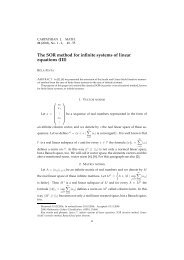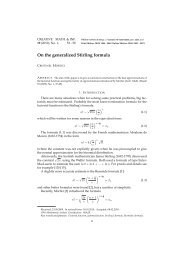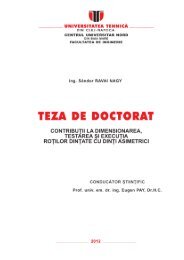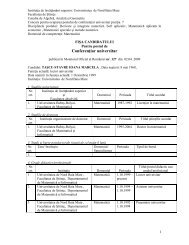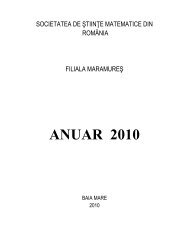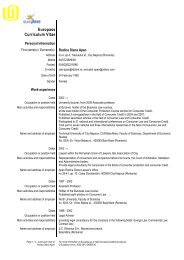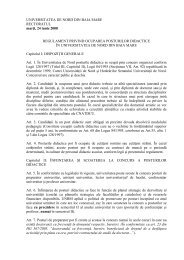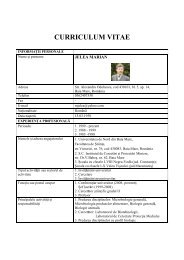Vol 3 (1) 2011 - UBM :: Departamentul de Chimie-Biologie
Vol 3 (1) 2011 - UBM :: Departamentul de Chimie-Biologie
Vol 3 (1) 2011 - UBM :: Departamentul de Chimie-Biologie
Create successful ePaper yourself
Turn your PDF publications into a flip-book with our unique Google optimized e-Paper software.
Carpathian Journal of Food Science and Technology <strong>2011</strong>, 3(1), 44-56<br />
Also the persistence of<br />
oxytetracycline at relatively high<br />
concentrations in the sediments for a<br />
significant period of time after medication<br />
exposed the tilapia for highly residual levels<br />
of oxytetracycline in their tissue [28].<br />
The quantitative assessment of<br />
oxytetracycline residual levels in the<br />
examined tilapia samples were showed in<br />
table (4). The inci<strong>de</strong>nce of oxytetracycline<br />
<strong>de</strong>tection in the examined samples of group<br />
I, II and III were 100% (60), 93.33% (60)<br />
and 53.33% (32) respectively. While the<br />
concentrations of oxytetracycline residues in<br />
the muscle of the tilapia were 319.92 ±<br />
12.18, 142.14 ± 4.86 and 75.49 ± 1.66 ppb<br />
for group I, II and III respectively. The<br />
results of group I was agreed with the results<br />
recor<strong>de</strong>d by Bernardy [29] while that of<br />
group II & III were lower. Also the obtained<br />
results were lower than that recor<strong>de</strong>d by<br />
Choo [30]. The differences between the<br />
obtained results and results of other studies<br />
may be attributed to the variation in the<br />
administrated dose whereas the high dose<br />
leads to more rapid excretion than low [31].<br />
It is result in an increase in the concentration<br />
of the antibiotic in the environment<br />
especially in the sediments [32, 28]. This<br />
increases the building up of antibiotic [33]<br />
and elongates antibacterial effects for 12<br />
weeks within sediment after the cessation of<br />
treatment [27]. Also the variation in the time<br />
of samples obtaining, during or after the<br />
withdrawal time (21 day) may affect in the<br />
levels of antibiotic residues ([34, 13].<br />
The abuse used of antibiotic either<br />
extensive uses of antibiotic to treat fish<br />
diseases nor ad<strong>de</strong>d as feed additives in<br />
aquaculture could results of hazards of<br />
antibiotic residues, the antibiotic resistance<br />
bacteria and resistance (R) plasmid in fish<br />
and water microflora [35, 36]. Also the<br />
presence of antibiotic in sewage and treated<br />
water and the administration of animal<br />
manure as feed could increase the potential<br />
risk [34]; consequently produce fish<br />
constitute potential risks to the consumers<br />
[37, 38]. Such as increase the inci<strong>de</strong>nce of<br />
foodborne infections due to their association<br />
of antibiotic resistance enteric bacteria and<br />
treatment failure in human [20].<br />
European Commission Council<br />
Regulation [39] set a standard permissible<br />
limit of oxytetracycline residual level in fish<br />
for human consumption. According to this<br />
limit, 100% (60) and 80% (48) of the group I<br />
and II were higher than the permissible<br />
limits and unfit for human consumption,<br />
while 13.33% (8) and 53.33% (32) of the<br />
group II and III were un<strong>de</strong>r the permissible<br />
limits and fit for human consumption. The<br />
inci<strong>de</strong>nce of the examined samples un<strong>de</strong>r the<br />
<strong>de</strong>tection levels (



